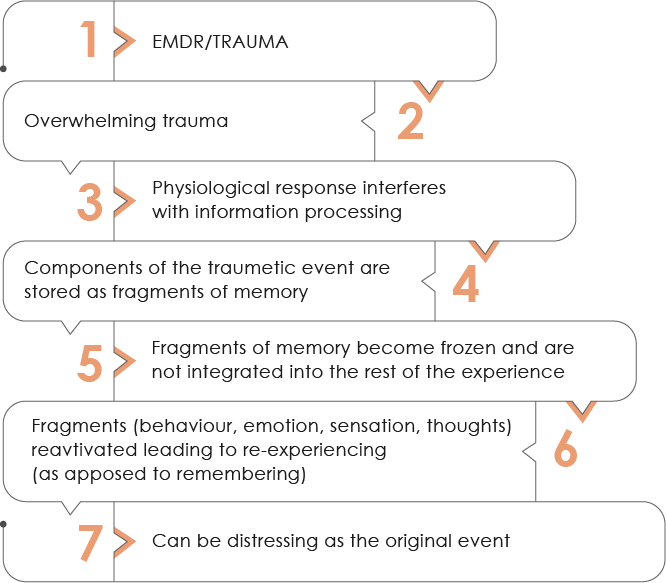What is EMDR?
EMDR (Eye Movement Desensitisation and Reprocessing) is a powerful therapy recognised by the World Health Organisation (WHO) and the National Institute for Health and Care Excellence (NICE). It’s a guiding light for individuals navigating through challenges triggered by traumatic events in their lives. Through EMDR, we gently guide the brain to process distressing memories in a way that eases their impact.
We harness the strength of EMDR therapy to address various forms of trauma, from PTSD and experiences of abuse to the aftermath of combat or crime. It extends its healing touch to individuals dealing with trauma-related concerns like depression, addiction, phobias, and struggles with self-esteem. Using EMDR interventions, we specifically target our client’s traumatic experiences and their impact on their emotional well-being.

How EMDR Can Help You
Traumatic stress arises from events that profoundly shock and overwhelm us emotionally. These events can involve real or threatened harm, risking our lives, causing serious injury, or threatening our physical well-being. They often fall outside the realm of our everyday experiences, leaving us feeling as though our lives are in imminent danger, and we may feel a loss of control. This could result from witnessing violence or being exposed to a disaster, leading to potentially severe psychological distress.
In the aftermath of such traumatic events, psychological responses typically manifest swiftly. Some individuals may experience mild and fleeting reactions, while others might grapple with intense and disabling emotions. Primary traumatic stress emerges from directly experiencing or witnessing the traumatic incident. Secondary, or vicarious traumatic stress, stems from engaging with or supporting individuals who have undergone similar traumatic experiences.
What is EMDR used to treat?
Post-traumatic stress disorder (PTSD) can emerge following exposure to extreme stressors that threaten one’s life, the lives of others, or involve sexual violence. It’s often accompanied by overwhelming feelings of fear, helplessness, or horror. The traumatic event(s) may persistently resurface through four main types of symptoms:
EMDR Case Study
(Warning some people may find this example distressing)
Mark (not his real name) is a 29-year-old security worker who came to therapy when he suffered a traumatic event at work. His workplace was robbed at gunpoint by a gang of hooded men who arrived suddenly and started shouting and threatening to shoot at anyone who moved. He was horrified that he had nearly died for just going to do his job. He stopped going to work as he found his role to be too dangerous. He retreated from his friends and co-workers. He became withdrawn from his friends and family saying that his world was shattered. He also felt guilty for having to hide for fear of his life. He said he could hear the shouting and screaming with the crackling sound of the guns for a long time. Mark’s symptoms included intrusive thoughts, flashbacks, nightmares, severe startle reaction and a sense that his life was over. He described his mood as anxious and depressed with difficulty sleeping and lack of energy. His relationship with his wife and children were severely impacted. He complained of loss of libido which impacted hugely on the sexual relationship with his wife. He no longer spent time with his two young children.
We discussed EMDR treatment with Mark helping him to understand how the maladaptively stored memory from the attack can be intruding and causing him to be upset. I explained that EMDR therapy can help him to process that memory to allow it to be stored appropriately. After 12 sessions of EMDR Mark reported improvement in his mood. The disturbing and upsetting memories was no longer a bother. His sleep and energy had improved significantly. His relationship with his wife started to improve and he started meeting up with a few trusted friends again. By the end of treatment, Mark said he felt ready to start his training and a new career in marketing.




